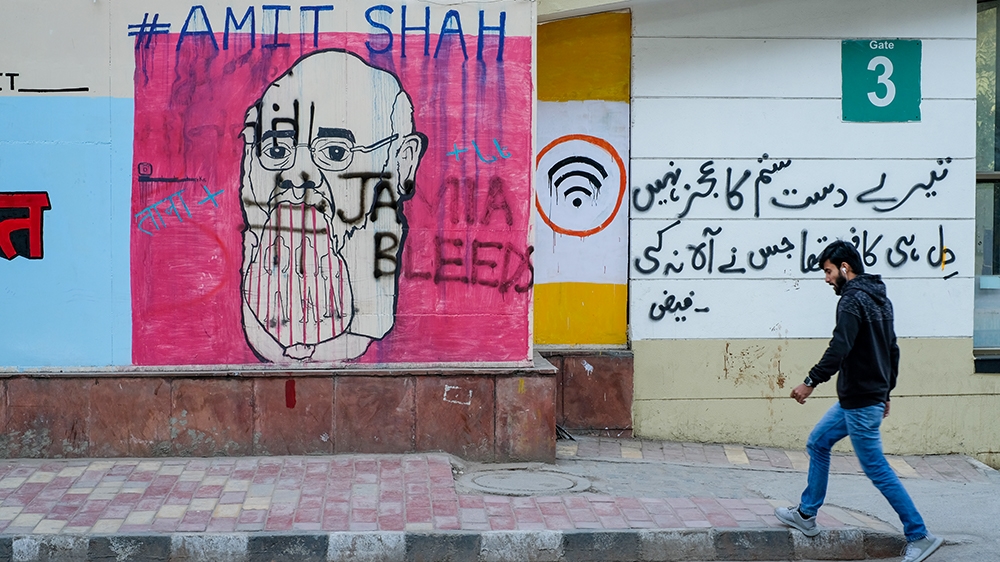Meet the artists resisting India’s new citizenship law
Young artists transform public spaces to raise awareness about new law which goes against country’s secular ethos.
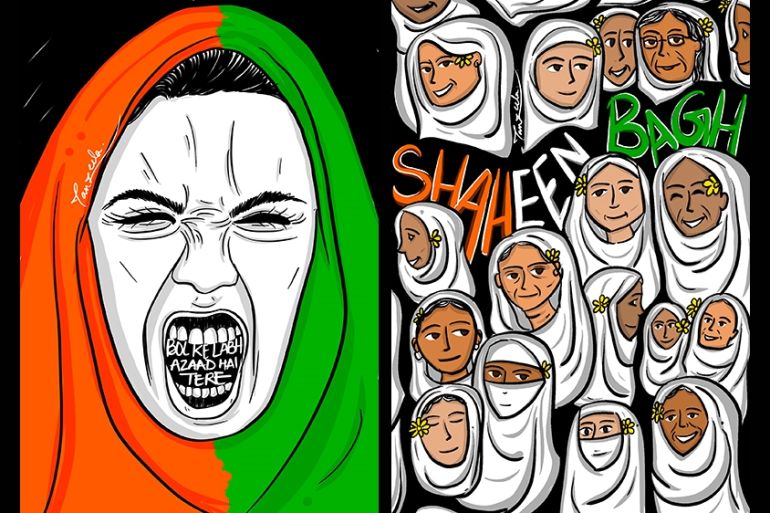
New Delhi, India – A large poster of a woman wearing hijab in the three colours of the Indian flag hangs over a highway signboard near Shaheen Bagh in the Indian capital of New Delhi. “Speak, for your lips are free,” the woman in the poster commands.
She appears again on a metro pillar nearby and again in the hands of protesters in Shaheen Bagh and across India.
Keep reading
list of 3 itemsFear in Kashmir as top general talks of ‘deradicalisation’ camps
Recipe for solidarity: How Indian protesters are being fed
For more than six weeks now, protesters across India have taken to the streets to oppose a controversial Citizenship Amendment Act (CAA), which they say discriminates against Muslims as it makes faith a basis for granting Indian citizenship.
The Hindu nationalist government says the law is meant to help persecuted minorities from three neighbouring countries, but critics say it undermines the country’s secular Constitution.
Muslims, Dalits and other marginalised groups in particular fear the planned nationwide counting of citizens (National Register of Citizens or NRC) could potentially render them stateless. A similar exercise in Assam state excluded nearly two million people from the citizenship list last year.
‘Celebration of democracy’
In New Delhi’s Shaheen Bagh and elsewhere, protesters have transformed public spaces with art.
“Art helps you resist and persist,” says Tanzeela, an advertising professional and the artist behind the now-iconic image of the woman in the tricolour hijab. Tanzeela found inspiration for her art in anger. “It broke me in so many ways that I was enraged,” she says.
Art is the medium through which I express myself best. I had stayed quiet for far too long, and I could no longer do so in the face of a clearly divisive law.
Tanzeela posted the image on her Instagram page as a form of self-expression. “I never thought my artwork would be shared across the country,” she says.
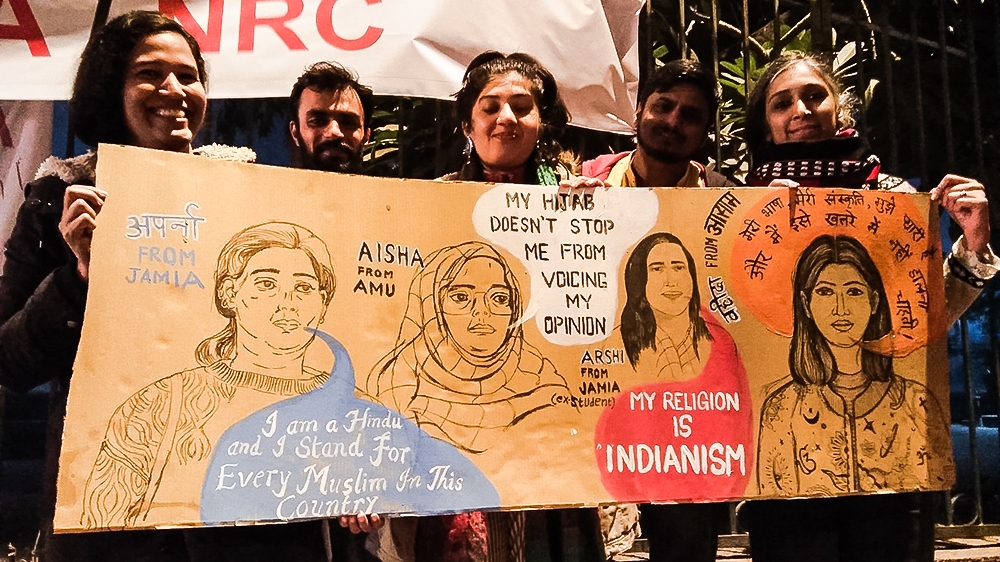
For Tanzeela, the illustration is closely linked to her identity. “It depicts an Indian-Muslim woman in a tricolour hijab and she is shouting the words of poet Faiz Ahmad Faiz,” she says, referring to Urdu poem Hum Dekhenge (We shall see) by the Pakistani Marxist author that has become an anthem of the biggest protests since Narendra Modi took over as prime minister in 2014.
“It is like a call to actually speak because now enough is enough.”
What started as protests have turned into “a celebration of what democracy is and what dissent can be”, says experience designer Anirban Ghosh.
A visit to Shaheen Bagh inspired Ghosh to create an illustration of the women there leading the protest. Holding candles and the Indian flag, the women in Ghosh’s artwork raise their fists in triumph.
“These protests are unlike any other in recent history,” says Ghosh, who is based in Kolkata. “They are a manifestation of the Gandhian philosophy of non-violence in such a spectacular way.”
Before Shaheen Bagh, Ghosh’s illustrations were not political. “Everyone has their own threshold, of taking a stand and starting to react,” he says. His art now covers the walls of Shaheen Bagh.
‘Art as a tool of solidarity‘
For 21-year-old self-taught graphic designer Lamya Khan, staying silent was no longer an option. “This law is the catalyst which galvanised me into action,” she says. “Art is the medium through which I express myself best. I had stayed quiet for far too long, and I could no longer do so in the face of a clearly divisive law.”
One of Khan’s illustrations depicts three women and raised fists – a tribute to the “resilience of women” protesting.
Art is one of the most powerful tools to resist any authoritarian regime.
“The common narrative is that Muslim women are weak, and are ‘not allowed’ to participate in politics. The stereotype is especially true for women in hijab. The Shaheen Bagh protest has shown us that these women can not only carry their own weight but also lead the way for an inclusive, secular platform to register dissent,” Khan told Al Jazeera.

Khan believes art is a powerful tool for resistance as “it can garner more attention by being provocative”. She says she wants to see her art widely used, as “this process builds a sense of community”.
“Art as a tool of solidarity is very important,” says new media artist Akshat Nauriyal, who created an Instagram filter that enables users to take selfies with visuals against the CAA. The filter had 80,000 impressions within two days.
Nauriyal created the filter to test how social media platforms can be used to engage with movements. A large young population and the increasing penetration of digital technology makes the online space as important as offline, says Nauriyal. “Seen in the context of the Citizenship Amendment Act, online protest and mobilisation helped drive people to the offline protests,” he adds.
Nauriyal thinks art helps bridge this space between online and offline protest. “When the aesthetic of a protest improves, people also participate, and feel like they can participate in a lot more ways,” he told Al Jazeera.
Art has the power to “dispel the barriers between a serious issue and the people, by making it accessible and easier to understand”, he says. “Creative expression is meant to transfer ideas. We’re seeing that happen through this protest art.”
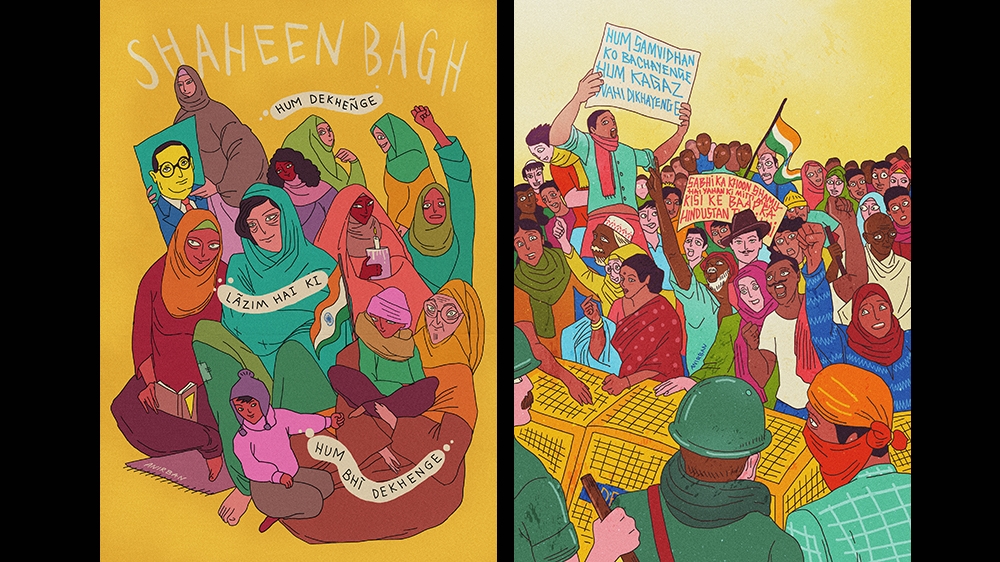
In Shaheen Bagh, a 40 foot-high (12 metres) iron and mesh installation of the Indian map symbolises the transfer of ideas. “The map gives a visual representation to the demands of the protesters here,” explains Rakesh Kumar, a social worker who designed and built the map with the help of colleagues and residents.
“When you take up an issue, the art itself is a point of interaction with people, and it helps communicate the importance of the issue to the wider public,” Kumar says. “This installation is on public streets, for everyone to see. It’s a map of India, and it says ‘We the people of India, reject CAA’ – so it represents the voice of protest, and says that we will not accept this black law; we reject it.”
The installation took eight days to complete. “Locals donated iron, gave us their time, and helped with whatever we needed – and together we built this iron map of India,” Kumar says.
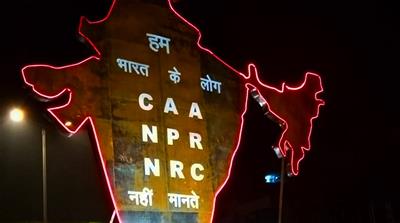
‘Respect existence or expect resistance’
Artist Gargi Chandola calls this the “creative collective conscience” flowing across the artist community and the wider public. “Art has the power to invoke the silent majority to come join the movement, as we are seeing with these protests,” she says.
Chandola discovered through social media that artists were gathering at the Jamia Millia Islamia university campus in New Delhi following a brutal police crackdown on students protesting the new citizenship law last month.
“Every day, we sat outside the university gate, displaying different posters on the footpath. We wanted to let the people of Jamia know that they were not alone,” she says.
Chandola believes art is central to dissent because people have “limited peaceful ways to protest”.
“Art is one of the most powerful tools to resist any authoritarian regime,” she says.
“The people on the other side, the oppressors, cannot do art,” Ghosh said. “What they can do is detain artists, break down installations, destroy or threaten.”
Tanzeela hopes her art will break the cycle of fear and help future generations assert themselves. “It is important for us to speak so that 10 years from now, a generation does not have to feel insecure,” she says.
Pasted next to Tanzeela’s image of the woman in the tricolour hijab on the signboard near Shaheen Bagh is a smaller poster with these words: “Respect existence or expect resistance.”
